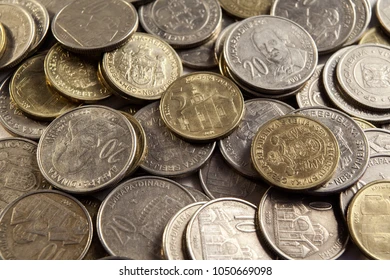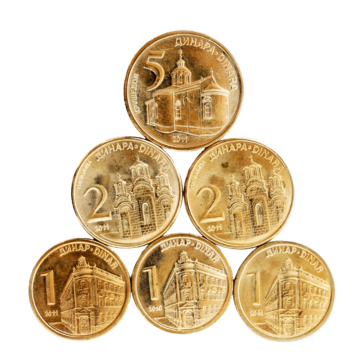Introduction:
The coins of contemporary Serbia are physical relics that attest to the history, cultural variety, and economic development of the country. From the early days of the Kingdom of Serbia until now, changes in political dynamics, creative manifestations, and the nation’s tenacity have all been reflected in the numismatic landscape. The coins of modern-day Serbia are examined in this article, along with their historical origins, significant historical periods, and the cultural meaning ingrained in these little yet powerful bits of metal.
I. Historical Overview: Numismatic Roots in Serbia
1. Medieval Beginnings:
- The history of Serbian numismatics begins in the Middle Ages, when different Serbian kingdoms struck coins to promote trade and establish their political dominance. Particularly the Nemanjić dynasty produced coins with inscriptions and symbols reflecting the political and religious climate of their day, leaving a major numismatic legacy.
2. Ottoman and Austrian Influences:
- The late medieval and early modern Ottoman Empire’s control over Serbia had an impact on coinage, bringing new themes and inscriptions. Afterwards, during the Austrian governance of Serbia, during the Habsburg-Ottoman Wars, the Austrian Empire put its mark on Serbian coinage.
II. The Kingdom of Serbia: Coins as Symbols of Independence
1. 19th Century Awakening:
- The Kingdom of Serbia gradually became an independent state throughout the 19th century. During this time, Serbia’s fight for independence and recognition was symbolized by the frequent appearance of national emblems, heraldic motifs, and the governing kings on coins.
2. Designs and Influences:
- During this time, numismatic designs included heraldic symbols and neoclassical elements, influenced by European artistic styles. The coins represented the goals and identity of the country in addition to being used as money.


III. The Kingdom of Yugoslavia: Unification in Coinage
1. The Formation of Yugoslavia:
- The Kingdom of Serbs, Croats, and Slovenes—later known as the Kingdom of Yugoslavia—was established following World War I. A single currency was adopted by the united state to represent the variety of civilizations found within its borders.
2. Artistic Expression:
- The creative depictions of the nation’s cultural variety were found on Yugoslav coins. To promote togetherness, the designs frequently used images from many areas and ethnic groups.
IV. Socialist Yugoslavia: Numismatic Narratives of Socialism
1. Socialist Themes:
- Under Josip Broz Tito, Yugoslavia was transformed into a socialist state after World War II. The numismatic world changed to reflect socialist ideas, with coins honoring labor, industrialization, and group accomplishments.
2. Commemorative Coins:
- Commemorative coins, honoring historical occasions, milestones, and socialist achievements, proliferated. These coins were used as vehicles for the spread of ideologies as well as a method of commerce.
V. The Breakup of Yugoslavia: Currency Changes and New Beginnings
1. Economic Turmoil:
- Early in the 1990s, Yugoslavia’s dissolution resulted in hyperinflation, new currency introductions in the successor republics, and economic difficulties. Stabilizing its currency was a challenge for Serbia, which constituted the majority of the former Yugoslavia.
2. Dinars and Hyperinflation:
- Because to the Yugoslav dinar’s hyperinflation in the 1990s, bigger denomination banknotes were issued. Frequent currency fluctuations during this age of economic turmoil are represented in the history of numismatics.
VI. Modern Serbia: Resilience and Euro Integration
1. Stability and the Dinar:
- Serbia pushed for economic stabilization and strengthened the dinar by enacting reforms in the 2000s. The currency’s stability came to represent Serbia’s tenacity in the face of monetary difficulties.
2. Euro Integration:
- Talks about making the euro the official currency gathered momentum as Serbia moved toward deeper cooperation with the EU. With ramifications for regional cooperation and economic stability, Serbia’s numismatic odyssey is about to embark on a new chapter with the possibility of joining the Eurozone.
VII. Cultural and Artistic Aspects of Serbian Coins
1. Cultural Symbols:
- Serbian coins have historically included depictions of historical personalities, religious emblems, and cultural icons. These emblems protect and promote the nation’s legacy in addition to acting as numismatic components and cultural ambassadors.
2. Commemorative and Collector’s Coins:
- Serbia may commemorate its rich history and cultural accomplishments by issuing collector’s and commemorative coins. These specialty coins are popular with collectors and individuals who want to preserve the nation’s history since they frequently include beautiful designs, rich metals, and restricted minting.


VIII. Challenges and Opportunities: The Future of Serbian Numismatics
1. Economic Challenges:
- Economic issues, such as currency changes and inflation, are a constant concern for Serbian numismatics. Future numismatic activities will continue to be shaped by the currency’s flexibility and endurance in the face of economic upheavals.
Conclusion:
In conclusion, the historical, cultural, and economic development of the country is reflected in the coins of contemporary Serbia, which capture a story spanning millennia. Serbian coins are physical evidence of the nation’s adaptation and durability, having seen them through the trials of the post-Yugoslav era as well as medieval kingdoms and communist Yugoslavia. Serbia’s numismatic environment has potential and difficulties as it navigates ongoing economic developments and seeks increased integration with the Eurozone. Modern Serbian coins provide a distinctive perspective on the country’s intricate and intriguing past because to their exquisite design and preservation of cultural icons.





